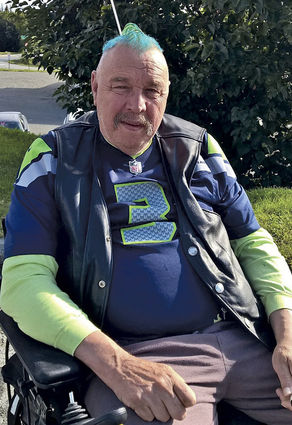Transition program eases return home

Photo courtesy Diana Marvin
Hank Wright, proud Seattle Seahawks fan, recently moved from Homer to Soldotna with help from the Nursing Facility Transition Program.
A limited income can trap some Alaskans in nursing or extended care, even when they're ready to return home or transition to assisted living. Fortunately, a state program can help people move to a lower level of care.
The Nursing Facility Transition Program can pay one-time costs to remove barriers to returning home, such as the need for a wheelchair ramp, or a deposit to move into an assisted living home.
To qualify, Alaskans must be 65 and older, or 21 and older with a physical disability, and eligible for a Medicaid waiver for home- and community-based services.
Diana Marvin said her father Hank Wright benefited from the program when Wright recently moved from extended care in Homer to assisted living in Soldotna. She contacted the Long Term Care Ombudsman's Office for ideas when she couldn't figure out how to get Wright's motorized wheelchair, which she said is several hundred pounds, to his new residence. The agency connected her with the program and she said the next thing she knew, transportation was arranged.
"It was a godsend," Marvin said.
Homer-area clients who have used the program in recent years received about $1,300 worth of help on average, said Joyanna Geisler, executive director of the Homer Independent Living Center.
About 30 Alaskans a year use the program, said Lisa Morley, grants manager for the state Division of Senior and Disabilities Services.
Cynthia Farrens of Mat-Su Care Coordination had a client who needed a stairlift installed so she could come home from the hospital a few years ago. The transition program's then-coordinator helped Farrens find a vendor who could do the work within the program's budget, she said, and the work was done before her client was discharged.
"It was just such a wonderful success story," Farrens said.
The program is a good one for care coordinators and discharge planners alike to tap, she said, because it helps smooth clients' path back into the community.
"The biggest thing is that nobody likes to pay for the cost of skilled nursing," Farrens said. "The cost to society at large is so great if we can't get them home where their care is a lot cheaper."
Am I eligible?
The Transition program, which is part of the state Division of Senior & Disabilities Services, helps adult Alaskans leave a nursing facility. To qualify, you must be age 65 or older, or be age 21 or older plus have a physical disability. You must also qualify for the Home and Community Based Services (HCBS) Medicaid waiver.
The program can help modify your home so you can live there, or help you move to an assisted living home.
The program can only help if the services you need are available where you want to live.
What does the program cover?
The program pays for most one-time things that people need when they move, such as:
• Modifications like safety rails in the bath or a wheelchair ramp;
• Travel costs for caregivers to get training;
• Trial trips to where you want to live;
• Security deposits;
• Move-in cleaning;
• Basic furnishings, like a bed and lamps;
• Transportation home.
How do I apply?
Have your care coordinator, nursing home social worker, or discharge planner call one of these contacts:
• Your regional Aging & Disability Resource Center, 877-625-2372
• Nursing Facility Transition Program, 907-269-4133 or 800-478-9996, toll free in Alaska
• Alzheimer's Resource Agency of Alaska, 907-561-3313 or 800-478-1080
Kenai Peninsula Independent Living Center, 800-770-7911
I applied ... Now what?
Program staff will arrange a meeting with you, your family member(s) and a care coordinator to develop a transition plan.
Next will be an assessment to make sure you are eligible for the HCBS Medicaid waiver program.
You and your care coordinator will choose a target date for your move, and then you and your team will work through the necessary steps. This process may take around one to three months, depending on what you need to make your transition successful.
The bottom line is that you have the right to decide where and how you live.









